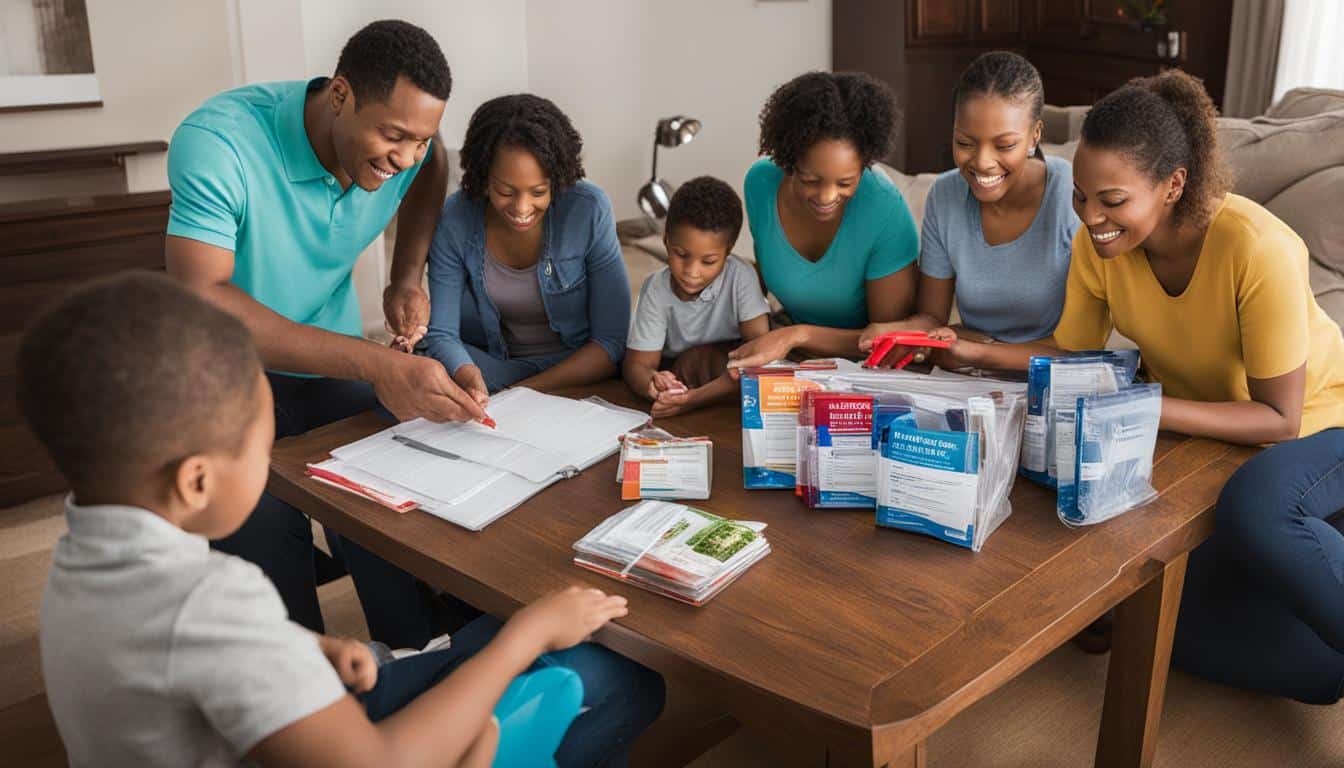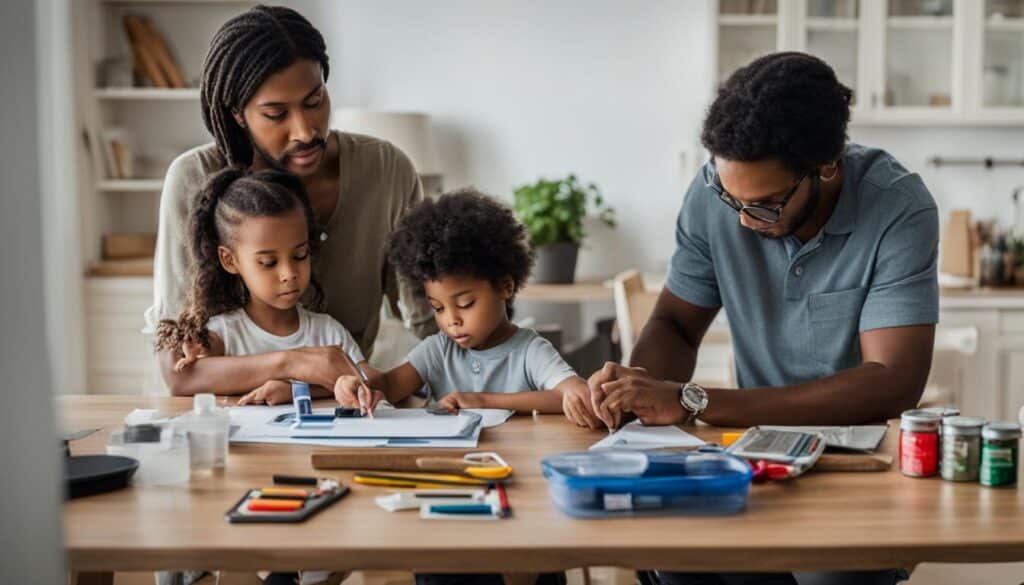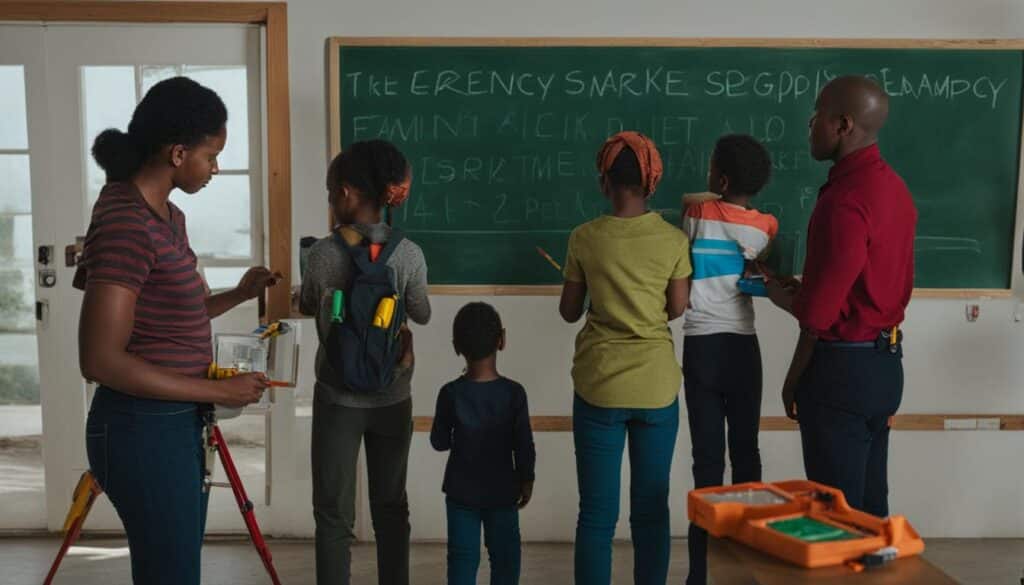
Family Emergency Preparedness: A Complete Guide
Protecting the safety and well-being of our loved ones is paramount, especially in times of crisis. This comprehensive family emergency preparedness guide will equip you with the knowledge and tools to effectively navigate through unexpected situations. By following these emergency preparedness tips, creating a thorough family emergency plan, and utilizing an emergency preparedness checklist, you can ensure that your family is prepared for any untoward event that may arise.
Key Takeaways:
- Understand the importance of family emergency preparedness and its role in ensuring the safety of your loved ones.
- Create a family emergency plan that takes into account the specific needs and responsibilities of each family member.
- Research and familiarize yourself with the potential disasters that may occur in your area.
- Establish a communication plan and designate safe meeting places for reunification.
- Consider special needs, such as medications, elderly care, and pet care, and plan accordingly.
Understanding Potential Disasters
When it comes to emergency preparedness, knowledge is power. Understanding the types of disasters that could potentially impact your area is crucial for taking appropriate actions. By familiarizing yourself with the different types of disasters, you can better prepare yourself and your family for any eventuality.
One of the first steps in understanding potential disasters is to research and identify the specific hazards that are most likely to occur in your region. These may include natural disasters such as hurricanes, earthquakes, floods, wildfires, or severe storms. By knowing the specific threats you face, you can tailor your emergency plan accordingly.
Additionally, it’s essential to be aware of the emergency alerts and warnings systems available in your area. These systems are designed to provide timely and crucial information about impending disasters, allowing you to take the necessary precautions. Stay informed by signing up for local emergency alert services and monitoring local news channels and radio stations for updates.
Having a shelter plan in place is also vital for your family’s safety during a disaster. Identify the safest areas of your home for each type of disaster, such as a basement for tornadoes or an interior room for earthquakes. Understanding where to seek shelter can significantly increase your chances of staying safe during a disaster.
In addition to a shelter plan, it’s crucial to establish evacuation routes in case you need to leave your home. Research and map out primary and secondary evacuation routes, ensuring you know how to reach safe locations such as emergency shelters or the homes of family and friends.
| Types of Disasters | Emergency Alerts and Warnings | Shelter Plan | Evacuation Route |
|---|---|---|---|
| Hurricanes | Local news channels | Interior room | Primary and secondary routes |
| Earthquakes | Local radio stations | Under sturdy furniture | Emergency shelter locations |
| Floods | Emergency alert services | Higher ground | Homes of family or friends |
| Wildfires | Mobile alert notifications | Safe evacuation zone | Designated meeting spots |
| Severe storms | Outdoor warning sirens | Interior room or basement | Alternative routes |
By understanding the potential disasters, staying informed with emergency alerts and warnings, knowing your shelter plan, and having evacuation routes in place, you can ensure your family’s safety during times of crisis. Take the necessary steps now to prepare for the unexpected and give yourself peace of mind.
Tailoring Your Plan to Specific Needs
Every family has unique needs and responsibilities. When creating your family emergency plan, it’s important to consider the different ages of your household members, their specific daily living needs, and responsibilities.
Start by assessing the daily living needs of each family member. This includes factors such as personal hygiene, food, water, and medication requirements. Make sure you have an adequate supply of essential items to sustain your family for at least 72 hours in case of an emergency.
Responsibilities within the family should also be accounted for in your emergency plan. Assign tasks to each family member based on their capabilities and areas of expertise. This can include roles such as contacting emergency services, caring for younger children, or ensuring the safety of elderly or disabled family members.
Incorporate dietary needs into your plan to ensure everyone’s well-being during a crisis. Consider any food allergies or restrictions and stock up on non-perishable items that meet these requirements. Additionally, have a plan in place to address special dietary needs such as a baby’s formula or specialized diets for medical conditions.
Medical needs are another critical aspect to consider. Take into account any pre-existing conditions, medications, and medical equipment that family members may rely on. Ensure you have an updated list of medications and contact information for healthcare providers. It’s also a good idea to keep a backup supply of essential medications in your emergency kit.
If any family members have disabilities or access requirements, tailor your plan to accommodate their needs. Identify potential barriers or challenges they may face during an emergency and develop strategies to address them. This can include accessible evacuation routes, specialized equipment, or communication aids.
Consider the languages spoken within your household when creating your emergency plan. Ensure that important information, such as emergency contacts and instructions, is available in the languages understood by all family members. This will help eliminate communication barriers and ensure everyone can follow the plan effectively.
Cultural considerations should also be taken into account to ensure the safety and well-being of all family members. Some cultures may have specific practices or dietary restrictions that need to be accommodated. Additionally, religious considerations may guide certain actions or rituals during an emergency.
By tailoring your family emergency plan to specific needs, you can effectively address the unique requirements of each family member. This will help ensure the safety, security, and well-being of your entire family during a disaster.

Creating a Family Emergency Plan
When it comes to preparing for a family emergency, having a well-structured plan in place is essential. By creating a family emergency plan, you can ensure that every member of your family knows what to do in case of a disaster. Here are some key steps to help you create an effective plan:
Gather Important Information
Start by gathering important contact information for each family member. This should include names, phone numbers, and addresses. Additionally, include the contact details of trusted neighbors, friends, or relatives who can be contacted during an emergency. By having this information readily available, you can quickly reach out and ensure everyone’s safety.
Designate Meeting Places
Choose designated meeting places both within your neighborhood and outside of it. These locations should be easily accessible and known to every family member. In case of an emergency, meeting at these predetermined locations will help you reunite with your loved ones.
Create Instructions for Various Scenarios
Consider different emergency scenarios and create clear instructions for each one. For example, determine the steps to take in case of a fire, earthquake, or severe weather event. These instructions should be detailed enough for every family member to understand and follow. Make sure to emphasize the importance of staying calm and following the plan.
Update Your Emergency Preparedness Kit
An emergency preparedness kit is a crucial component of your family emergency plan. Regularly update it with any necessary supplies, such as non-perishable food, water, first aid items, flashlights, and batteries. Ensure that everyone in your family knows where the kit is located and how to use its contents.
Practice Drills
Regularly practicing drills with your family is an excellent way to ensure everyone knows what to do during a disaster. Conduct fire drills, evacuation drills, and other emergency scenario simulations. This practice will help build confidence, familiarize everyone with the plan, and identify any areas that need improvement.

Essential Items for an Emergency Preparedness Kit
| Item | Quantity |
|---|---|
| Water | One gallon per person per day |
| Non-perishable food | At least a three-day supply |
| First aid kit | Include necessary medications and supplies |
| Flashlights | Have at least one flashlight per person |
| Batteries | Ensure they are fresh and replace as needed |
| Whistle | To signal for help |
| Emergency blanket | For warmth |
| Portable phone charger | To keep communication devices powered |
| Extra clothes and sturdy shoes | For each family member |
Remember, being prepared is the key to effectively dealing with a family emergency. By following these steps, using a fillable form or template, updating your emergency preparedness kit, and practicing drills with your family, you can ensure that everyone knows what to do and increase your family’s overall safety.
Communication and Reunification
In case of an emergency, it’s crucial to have a solid communication plan in place for your family. This plan ensures that everyone is aware of emergency contact information and knows where to reunite after a disaster. By establishing a communication plan, you can effectively stay connected and ensure the safety and well-being of your loved ones.
Emergency Contact Information
One of the key components of a communication plan is having up-to-date emergency contact information for all family members. This includes phone numbers and addresses of immediate family, neighbors, and other essential contacts. Create a list with this information and distribute it to each family member, keeping a physical copy in a safe location as well.
Designating a Safe Reunification Place
Choose a safe and easily accessible location where your family can reunite after a disaster. This could be a nearby park, a community center, or any other place that is unlikely to be affected by the emergency. Make sure that everyone knows the address and phone number of this designated meeting place.
“Establishing a pre-determined reunification point is crucial for ensuring the safety and well-being of your family members during a disaster. It provides a sense of security and a designated meeting place where everyone can gather and account for each other.” – John Smith, Emergency Preparedness Expert
Out-of-Town Contact
In some situations, local communication systems may be unreliable or unavailable during a disaster. To overcome this challenge, consider designating an out-of-town contact who can serve as a central point of communication. This person can help relay information between family members and provide updates on everyone’s well-being.
Having a communication plan and a reunification strategy ensures that your family can stay connected and find each other in the aftermath of a disaster. It provides peace of mind and enhances the overall preparedness of your family in emergency situations.
Special Considerations and Resources
When preparing your family emergency plan, it is important to consider any special needs that you or your loved ones may have. By planning accordingly, you can ensure that everyone’s needs are met and that the necessary resources are available during a disaster.
Medications
In the event of an emergency, having an adequate supply of medications is crucial. Make sure to include a list of all necessary medications in your family emergency plan, along with dosage instructions and any other relevant information. Consider creating a designated emergency medication kit that can be easily accessed and transported during evacuation.
Elderly Care
If you have elderly family members, it is essential to make specific arrangements for their care during a disaster. Ensure that you have a communication plan in place to stay connected and informed about their well-being. Discuss any mobility or medical concerns with healthcare providers and develop a plan to address their unique needs in the event of an emergency.
Pet Care
Don’t forget about your furry friends during emergency planning. Create a pet emergency kit that includes food, water, medications, and any necessary supplies. Identify pet-friendly evacuation shelters or accommodations in advance, and have a plan for transporting your pets safely. Consider microchipping your pets and keeping their identification up to date to ensure a swift reunion if you become separated during a disaster.
Resources for Special Needs
“During an emergency, it’s important to be aware of the available resources in your community that can provide assistance. Reach out to local organizations, such as the Red Cross or disability services agencies, that specialize in supporting individuals with special needs. They can provide valuable information, guidance, and access to additional resources.”
| Organization | Services Provided | Contact Information |
|---|---|---|
| Red Cross | Emergency shelter and support services | www.redcross.org 1-800-RED-CROSS |
| Disability Services Agency | Assistance for individuals with disabilities | www.disabilityagency.org 1-888-555-1234 |
| Animal Shelter | Pet care and temporary housing | www.animalshelter.org 1-800-PETS-NEEDS |
Take the time to research and familiarize yourself with these resources before an emergency occurs. Knowing where to turn for help can provide peace of mind and ensure the well-being of your family members with special needs.
Conclusion
In conclusion, prioritizing family emergency preparedness is essential for safeguarding the well-being of your loved ones. By utilizing this comprehensive family emergency preparedness guide, you can develop a robust emergency plan, gather vital emergency preparedness supplies, and gain a deep understanding of potential disasters in your area.
Remember the importance of regularly reviewing and updating your plan to ensure your family stays prepared for any challenging situation that may arise. Being proactive and prepared significantly reduces the risk of being caught off guard during an emergency.
Investing time and effort in creating a family emergency plan, assembling emergency preparedness supplies, and familiarizing yourself with potential disasters empowers you to navigate through difficult circumstances successfully. Prioritize the safety and well-being of your family by following this invaluable emergency planning guide.
FAQ
Why is it important to have a family emergency plan?
Having a family emergency plan is crucial because it ensures that everyone in your family knows what to do and where to go in the event of a disaster. It helps to minimize panic, confusion, and ensures the safety and well-being of your loved ones.
How do I understand potential disasters in my area?
Start by researching and understanding the types of disasters that are most likely to occur in your specific area. This information can be obtained from local emergency management agencies or online resources. Knowing the potential disasters will help you make informed decisions and take appropriate actions if needed.
What should I consider when tailoring my emergency plan to specific needs?
When tailoring your emergency plan, consider the different ages, daily living needs, and responsibilities of each family member. Take into account dietary and medical needs, disabilities or access requirements, languages spoken, and cultural considerations. This ensures that your plan is comprehensive and addresses the unique needs of your family members.
How do I create a family emergency plan?
Use a fillable form or template to create your family emergency plan. Include important contact information, meeting places, and instructions for various emergency scenarios. Make sure to update your emergency preparedness kit with necessary supplies and practice drills with your family regularly.
What should be included in a communication plan?
A communication plan should include emergency contact information such as phone numbers and addresses of family members, neighbors, and other essential contacts. It is also important to designate a safe place where your family can reunite after a disaster and make sure everyone knows the address and phone number. Consider designating an out-of-town contact who can help relay information if local communication systems are unavailable.
What special considerations and resources should I be aware of?
Identify any special needs within your family, such as adequate supply of medications, arrangements for elderly family members, and plans for the care of pets. Consider the unique needs of children, individuals with disabilities, and any specific dietary or medical requirements. Research available resources in your community that can provide assistance during a disaster.
How can I ensure my family is prepared for any situation?
Being proactive and prepared is crucial. Use this comprehensive family emergency preparedness guide to create a solid emergency plan, gather necessary supplies, and familiarize yourself with potential disasters in your area. Regularly review and update your plan to ensure your family is always prepared for any situation that may arise.